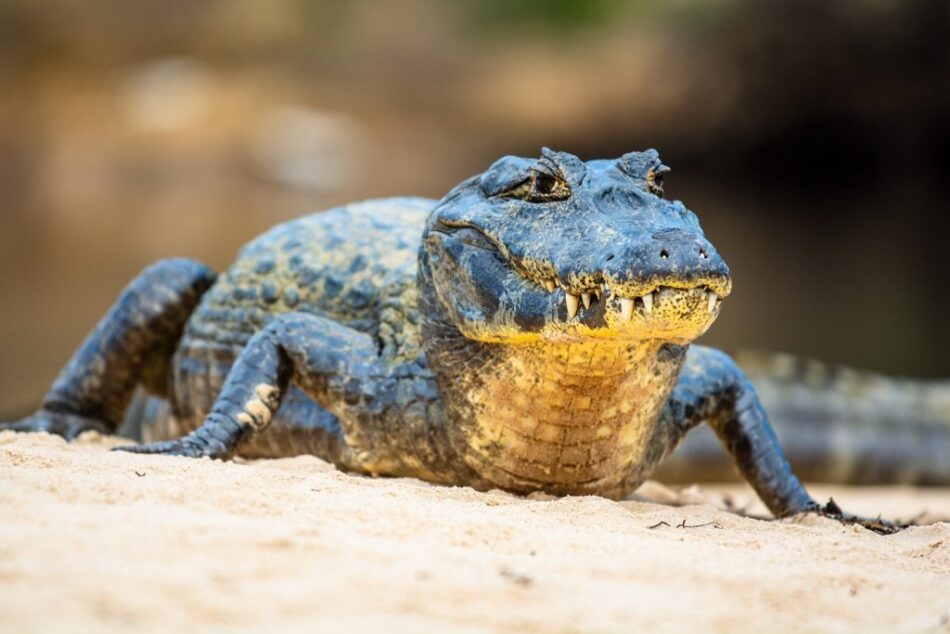Are there alligators in argentina? Yes, indded. In Argentina’s northeast region, a distinctive native species reigns supreme – the Yacaré Overo, or broad-snouted caiman (Caiman latirostris). This blog post delves into the fascinating world of this crucial denizen of the region’s wetlands, a highlight for Hotel Puerto Valle’s guests enjoying immersive tours in its natural habitat.
characteristics of the yacaré overo
What type of animal is the Yacaré Overo? Learn right here below about this notable family member of caimans and alligators. of South America’s wetlands.
- The Yacaré Overo, also recognized as the Broad-snouted Caiman, is a large-sized lizard, with two and a half meters in length, aproximately. This animal is characterized by its intriguing behavior.
- Thriving in regions abundant with dense vegetation and a tropical climate, this remarkable creature gracefully swims through estuaries. Noteworthy is its delightful tendency to bask in the sun amid reservoirs, marshes, and shrub-covered landscapes.
- The Yacaré Overo boasts an exclusively carnivorous diet, centered around snails, mollusks, and crustaceans. Additionally, it exhibits a keen prowess for capturing other reptiles and small mammals.
Yacar’es are non-aggressive by nature and they usually avoid human interactions. Their instinctive fear of people leads them to avoid unnecessary confrontations, as they prefer to conserve their energy for essential activities such as feeding.

Why is the Yacaré Overo a threatened species?
Did you know that the Yacarè Overo is an endangered species? Yes, the broad-snouted caiman, an alligator species under threat and faces several challenges that jeopardize its survival. Notably, not all specimens reach adulthood, becoming vulnerable prey for birds soaring over the region.
Compounding this, illegal hunting poses a significant threat to the Yacarè population, driven by the demand for caiman skin, valued in the leather goods industry, as well as its meat and eggs sought after for culinary purposes.
How are these alligator specimens reintroduced to their natural habitat?
- The ranching process of the Yacaré Overo involves allowing breeders to thrive in their natural environment while carefully relocating their eggs to artificial incubators. Given that caimans are cold-blooded and exhibit peak activity during spring and summer, they lay a limited clutch of eggs—ranging from 20 to 50—only once a year.
- In their native habitat, less than 2% of the specimens born in the wild successfully transition to adulthood, underscoring the critical challenges faced by these creatures in their natural lifecycle.
- Regional authorities and activists work to prevent the loss of alligator babies during their early stages, in order to increase their chances of reaching adulthood. By carefully maintaining optimal temperature and humidity conditions, there is a significant potential to boost the number of individuals that will eventually contribute to the adult population.
- In a proactive approach, Yacaré’s eggs are systematically placed in numbered troughs within a suitable incubator. Upon hatching, the young lizards undergo a meticulous process—measurement, marking by nest number, weighing, and disinfection—before being relocated to the breeding pool, where they spend their first year.
- Through restocking initiatives, a substantial number of animals born in captivity supplement the wild population. This strategic approach allocates a percentage for commercial purposes and another percentage for reintroduction into their natural habitat, thereby ensuring the preservation of the wild population.
- The commitment to conservation extends to the careful reintroduction of the young Yacaré to the very locations where their eggs were initially gathered, a process facilitated by the numbered nests. Prior to their release, each individual undergoes a comprehensive assessment—weighing, measuring, determination of sex, and a thorough health check. This meticulous approach ensures not only their seamless return to the wild but also contributes to the overall well-being and sustainability of the Yacaré population.
Our experience with the broad-snouted caiman
In Esteros del Iberá, visitors have the opportunity to see the broad-snouted caiman in the vicinity of Portal Cambyretá and Laguna Valle. During their stay in Puerto Valle, guests can go on a Safari of the Iberá National Park and an Expedition to Laguna Valle to live a one-of-a-kind experience surrounded by unique species. Guides share with visitors the main characteristics of local species and explain the restocking efforts, including the case of the Red Macaw and the Yacaré Overo.

